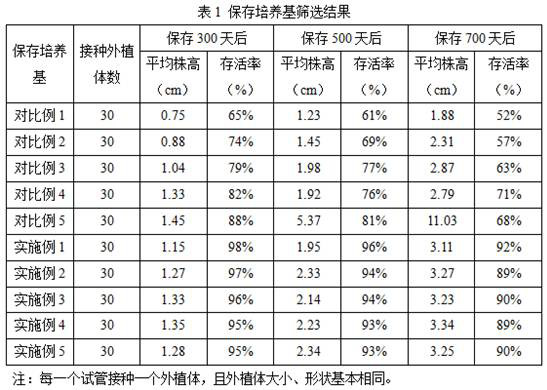A kind of living preservation method of lily
A preservation method and technology for lily, applied in the field of plant biology, can solve the problems of short storage time in vitro, affecting the quality of lily, etc., and achieve the effects of long-term preservation, reduction of preservation cost, and improvement of survival rate.
- Summary
- Abstract
- Description
- Claims
- Application Information
AI Technical Summary
Problems solved by technology
Method used
Image
Examples
Embodiment 1
[0041] A method for preserving lilies in vivo, comprising the following steps:
[0042] Step 1: Select lily bulbs with a diameter of 6 cm, and peel off the outer scales of the bulbs as explants for living preservation;
[0043] Step 2: Sterilize the explants. Put the explants into a sterile container on the ultra-clean table, soak them in 75% alcohol for 2 minutes, take out the explants, and rinse them with sterile water for 5 times. Then use 0.1HgCl 2 Soak in the solution for 20 minutes, then rinse with sterile water for 5 times, each time for 3 minutes, and finally dry the water with sterile filter paper;
[0044] Step 3: placing the sterilized explants into the prepared preservation medium for living preservation;
[0045] The preservation medium is:
[0046] Improved MS+inositol 0.2g / L+mannitol 500mg / L+silver nitrate 0.5mg / L
[0047] The improved MS formula is: the content of major elements is reduced by 50%, and the rest of the ingredients remain unchanged;
[0048] ...
Embodiment 2
[0055] A method for preserving lilies in vivo, comprising the following steps:
[0056] Step 1: Select lily bulbs with a diameter of 6 cm, and peel off the outer scales of the bulbs as explants for living preservation;
[0057] Step 2: Sterilize the explants. Put the explants into a sterile container on the ultra-clean table, soak them in 75% alcohol for 2 minutes, take out the explants, and rinse them with sterile water for 5 times. Then use 0.1HgCl 2 Soak in the solution for 20 minutes, then rinse with sterile water for 5 times, each time for 3 minutes, and finally dry the water with sterile filter paper;
[0058] Step 3: placing the sterilized explants into the prepared preservation medium for living preservation;
[0059] The preservation medium is:
[0060]Improved MS+inositol 0.15g / L+mannitol 500mg / L+silver nitrate 0.2mg / L
[0061] The improved MS formula is: the content of major elements is reduced by 50%, and the rest of the ingredients remain unchanged;
[0062] ...
Embodiment 3
[0065] A method for preserving lilies in vivo, comprising the following steps:
[0066] Step 1: Select lily bulbs with a diameter of 6 cm, and peel off the outer scales of the bulbs as explants for living preservation;
[0067] Step 2: Sterilize the explants. Put the explants into a sterile container on the ultra-clean table, soak them in 75% alcohol for 2 minutes, take out the explants, and rinse them with sterile water for 5 times. Then use 0.1HgCl 2 Soak in the solution for 20 minutes, then rinse with sterile water for 5 times, each time for 3 minutes, and finally dry the water with sterile filter paper;
[0068] Step 3: placing the sterilized explants into the prepared preservation medium for living preservation;
[0069] The preservation medium is:
[0070] Improved MS+inositol 0.15g / L+mannitol 500mg / L+silver nitrate 0.6mg / L
[0071] The improved MS formula is: the content of major elements is reduced by 50%, and the rest of the ingredients remain unchanged;
[0072]...
PUM
 Login to View More
Login to View More Abstract
Description
Claims
Application Information
 Login to View More
Login to View More - R&D
- Intellectual Property
- Life Sciences
- Materials
- Tech Scout
- Unparalleled Data Quality
- Higher Quality Content
- 60% Fewer Hallucinations
Browse by: Latest US Patents, China's latest patents, Technical Efficacy Thesaurus, Application Domain, Technology Topic, Popular Technical Reports.
© 2025 PatSnap. All rights reserved.Legal|Privacy policy|Modern Slavery Act Transparency Statement|Sitemap|About US| Contact US: help@patsnap.com

